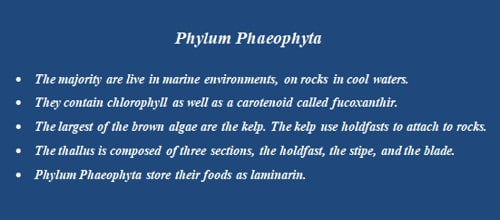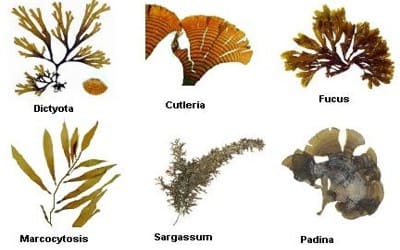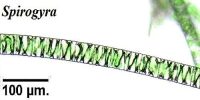Phaeophyta is greenish-brown colored algae that include fucoxanthin, beta-carotene, and chlorophyll a and c. The length of Phaeophyta can range from a microscopic length to several meters. The longest size measured is about 30 meters. They are the most multifaceted forms of algae, usually adopted in the sea atmosphere.
Characteristics of the phylum Phaeophyta:
(1) They are composed of Eukaryotic and Prokaryotic cells, with special type of excretory granules in vesicles.
(2) They are mainly marine with a unicellular or multicellular body, only four or five species are freshwater living.
(3) They are multicellular filamentous and complex in nature. They are the most complex forms of algae. The cell walls are composed of cellulose and alginic acid.
(4) Chief pigments are chlorophyll a and c, beta carotene. lutein, fucoxanthin, dioanthin, and violaxanthin.
(5) Higher Phaeophyta has a life cycle consisting of both haploid and diploid stages, referred to as an alternation of generation. Similar to other evolved algal species, reproduction of this algae takes place by both sexual and asexual means.

(6) They are brown in color because brown pigments are more in the cells than other pigments
(7) Polysaccharides and alcohol are stored as reserve food. The food reserves contain sugar, higher alcohol and other complex forms of polysaccharides. Reserve food includes laminarin, mannitol, and oils.
(8) Alternation of generation is found in most of the species. The life cycle is haplobiotic or diplobiotic, with alternation of generations.
(9) Their gametes or zoospores have flagella of different sizes. Zoospore formation is common.
(10) The members of Phaeophyta belonging to Laminarales are called kelps. Kelps are the only algae with momentous interior tissue differentiation.
(11) Male gametes are flagellate. Flagella are heterokont. Sexual reproduction is isogamous, anisogamous or oogamous.
(12) They reproduce by all the three means: vegetative, asexual and sexual.

Example: Sargassum (gulfweed), Fucus (rockweed), and the simple filamentous Ectocarpus are other examples of Phylum Phaeophyta.












